Sonicwall 027 802.11b VPN Access point User Manual user2
Sonicwall, Inc. 802.11b VPN Access point user2
user2

Page 24 SonicWALL Internet Security Appliance Administrator’s Guide
3 Configuring Wireless on the SOHO TZW
The SOHO TZW uses a wireless protocol called IEEE 802.11b, commonly known as Wi-Fi, and
sends data via radio transmissions. Wi-Fi transmission speed is usually faster than broadband
connection speed, but it is slower than Ethernet.
The SonicWALL SOHO TZW combines three networking components to offer a fully secure
wireless firewall: an 802.11b Access Point, a secure wireless gateway, and a stateful firewall
with flexible NAT and VPN termination and initiation capabilities. With this combination, the
SOHO TZW offers the flexibility of wireless without compromising network security.
Typically, the SOHO TZW is the access point for your wireless LAN and serves as the central
access point for computers on your LAN. In addition, it shares a single broadband connection
with the computers on your network. Since the SOHO TZW also provides firewall protection,
intruders from the Internet cannot access the computers or files on your network. This is
especially important for an “always-on” connection such as a cable modem or T1 line that is
shared by computers on a network.
However, wireless LANs are vulnerable to “eavesdropping” by other wireless networks which
means you should establish a wireless security policy for your wireless LAN. Wired Equivalent
Privacy, WEP, should not be used as your only security policy.
On the SOHO TZW, wireless clients connect to the Access Point layer of the firewall. Instead
of bridging the connection directly to the wired network, wireless traffic is first passed to the
Secure Wireless Gateway layer where the client is required to be authenticated via User Level
Authentication. Access to Wireless Guest Services (WGS) and Access Control Lists (ACL) are
managed by the SOHO TZW. It is also at this layer that the SOHO TZW has the capability of
enforcing WiFiSec, and IPSec-based VPN overlay for wireless networking. As wireless network
traffic sucessfully passes through these layers, it is then passed to the VPN-NAT-Stateful
firewall layer where WiFiSec termination, address translation, and access rules are applied. If
all of the security criteria is met, then wireless network traffic can then pass via one of the
following Distribution Systems (DS):
•LAN
•WAN
• Wireless Client on the WLAN
• VPN tunnel

Configuring Wireless on the SOHO TZW Page 25
Considerations for Using Wireless Connections
•Mobility - if the majority of your network is laptop computers, wireless is more portable than
wired connections.
•Convenience - wireless networks do not require cabling of individual computers or opening
computer cases to install network cards.
•Speed - if network speed is important to you, you may want to consider using Ethernet
connections rather than wireless connections.
•Range and Coverage - if your network environment contains numerous physical barriers
or interference factors, wireless networking may not be suitable for your network.
•Security - wireless networks have inherent security issues due to the unrestrictive nature
of the wireless transmissions. However, the SOHO TZW is a firewall and has NAT
capabilities which provides security, and you can use WEP to secure data transmissions.
Recommendations for Optimal Wireless Performance
• Place the SOHO TZW near the center of your intended network. This can also reduce the
possibility of eavesdropping by neighboring wireless networks.
• Minimize the number of walls or ceilings between the SOHO TZW and the receiving points
such as PCs or laptops.
• Try to place the TZW in a direct line with other wireless components. Best performance is
achieved when wireless components are in direct line of sight with each other.
• Building construction can make a difference on wireless performance. Avoid placing the
TZX near walls, fireplaces, or other large solid objects. Placing the TZW near metal objects
such as computer cases, monitors, and appliances can affect performance of the unit.
• Metal framing, UV window film, concrete or masonry walls, and metallic paint can reduce
signal strength if the TZW is installed near these types of materials.
• Installing the TZW in a high place can help avoid obstacles and improve performance for
upper stories of a building.
• Neighboring wireless networks and devices can affect signal strength, speed, and range of
the SOHO TZW. Also, devices such as cordless phones, radios, microwave ovens, and
televisions may cause interference on the TZW.
Adjusting the SOHO TZW Antennas
The antennas on the SOHO TZW can be adjusted for the best radio reception. Begin with the
antennas pointing straight up, and then adjust as necessary. Note that certain areas, such as
the area directly below the SOHO TZW, get relatively poor reception. Pointing the antenna
directly at another wireless device does not improve reception. Do not place the antennas next
to metal doors or walls as this can cause interference.

Page 26 SonicWALL Internet Security Appliance Administrator’s Guide
Wireless Guest Services (WGS)
With your SOHO TZW, you can provide wireless guest services to wireless-equipped users
who are not part of your corporate network, for example, a consultant or a sales person. You
can offer authenticated wireless users access to the Internet through your SOHO TZW while
preventing them from accessing your corporate LAN, or allowing them access to specific
resources on the LAN and unencrypted access to the Internet.
When WGS is active, wireless clients can authenticate and associate with the Access Layer of
the SonicWALL. When a Web browser is launched, the wireless user is prompted to provide a
user name and password to gain access to WGS. The browser is redirected to the HTTP
(unencrypted) management address of the SOHO TZW, but the user name and password is
not transmitted. Instead, a secure hash is transmitted rendering the information useless to
anyone “eavesdropping” on the network. After authentication, WGS is tracked and controlled
by the client MAC address as well as Account and Session lifetimes.
In order to take advantage of Wireless Guest Services, you must provide a guest with a user
name and password which they use to authenticate themselves using HTTP and a Web
browser, creating a secure HTTP session. For more information on configuring Wireless Guest
Services, see page X, Configuring Wireless Guest Services.
Easy ACL (Access Control Lists)
802.11 wireless networking protocol provides native MAC address filtering capabilities. When
MAC address filtering occurs at the 802.11 layer, wireless clients are prevented from
authenticating and associating with the wireless access point. Since data communications
cannot occur without authentication and association, access to the network cannot be granted
until the client has given the network administrator the MAC address of their wireless network
card.
The SOHO TZW uses its WGS to overcome this limitation by moving MAC address filtering to
the Secure Wireless Gateway layer. This allows wireless users to authenticate and associate
with the Access Point layer of the SonicWALL, and be redirected to the WGS by the Secure
Wireless Gateway where the user authenticates and obtains WLAN to WAN access.
Easy ACL is an extension of WGS that simplifies the administrative burden of manually adding
MAC addresses to the ACL. Users can add themselves to the ACL by providing a user name
and password assigned to them by the SonicWALL administrator. WGS must be enabled on
the SOHO TZW before Easy ACL can be implemented.
WiFiSec Enforcement
Enabling WiFiSec Enforcement on the SonicWALL enforces the use of IPSec-based VPN for
access from the WLAN to the LAN, and provides access from the WLAN to the WAN
independent of WGS. Access from one wireless client to another is configured on the
Wireless>Advanced page where you can disable or enable access between wireless clients.
WiFiSec uses the easy provisioning capabilities of the SonicWALL Global VPN client making it
easy for experienced and inexperienced administrators to implement on the network. The level
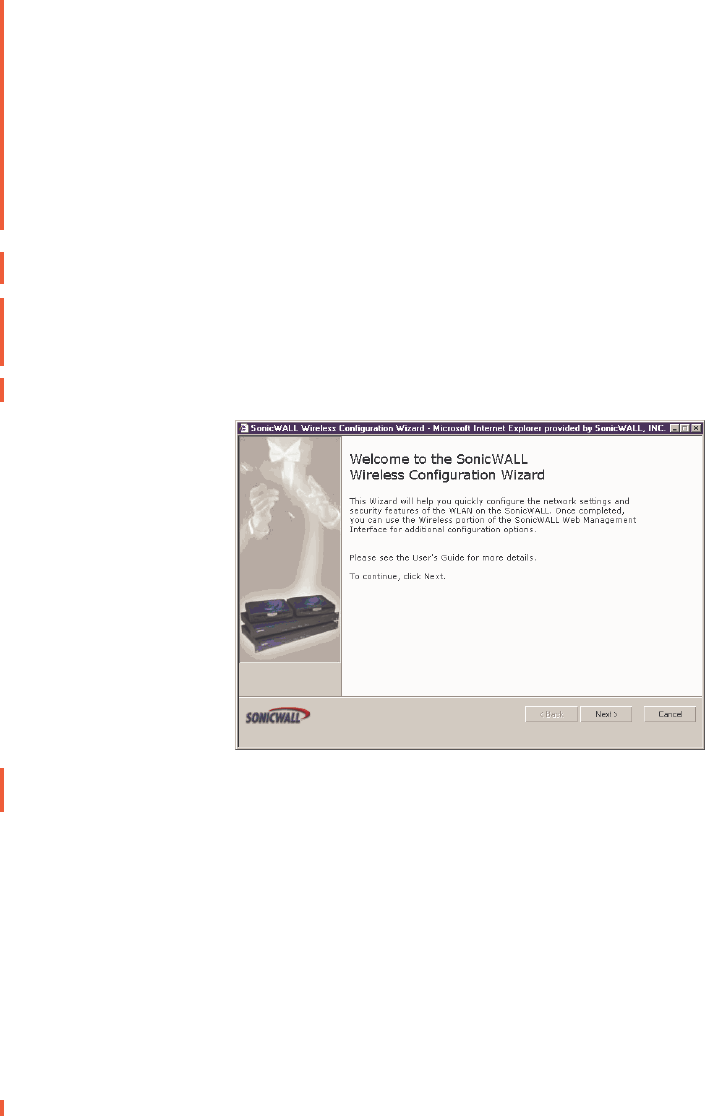
Configuring Wireless on the SOHO TZW Page 27
of interaction between the Global VPN Client and the user depends on the WiFiSec options
selected by the administrator. WiFiSec IPSec terminates on the WLAN/LAN port, and is
configured using the Group VPN Security Policy including noneditable parameters specifically
for wireless access.
•Apply NAT & Firewall Rules - On
•Forward Packets to Remote VPNs - On
•Default LAN Gateway - <management IP Address> if left unspecified
•VPN Terminated at the LAN/WLAN - to differentiate between VPN Security Associations
terminated at the WAN port.
Configuring Your Wireless Network
You can use the Wireless Wizard to quickly and easily set up your wireless network. Log into
the SOHO TZW, and click Wireless on the menu bar. Click Wireless Wizard to launch the
wizard and begin the configuration process.
Welcome to the SonicWALL Wireless Configuration Wizard
1. When the Wireless Wizard launches, the Welcome page is displayed. Click Next to
continue configuration.
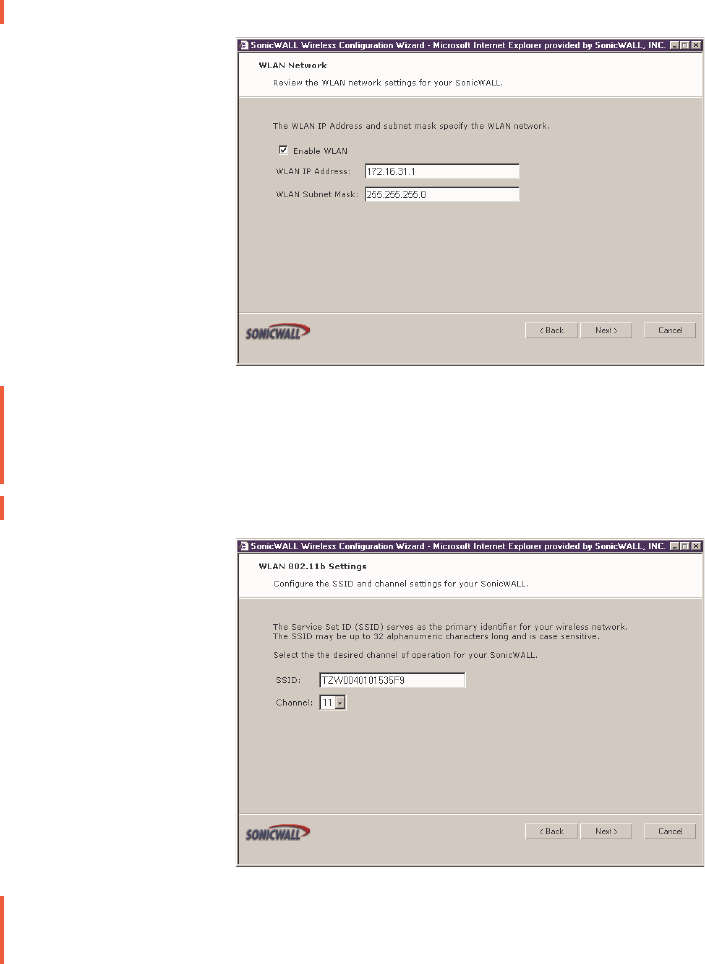
Page 28 SonicWALL Internet Security Appliance Administrator’s Guide
WLAN Network Settings
2. Select Enable WLAN to activate the wireless feature of the SOHO TZW. Use the default
IP address for the WLAN or choose a different private IP address. The default value works
for most networks. Click Next to continue.
Alert! You cannot use the same private IP address range as the LAN port of the SOHO TZW.
WLAN 802.11b Settings
3. Enter a unique identifier for the SOHO TZW in the SSID field. It can be up to 32
alphanumeric characters in length and is case-sensitive. The default value is the serial
number of the appliance.
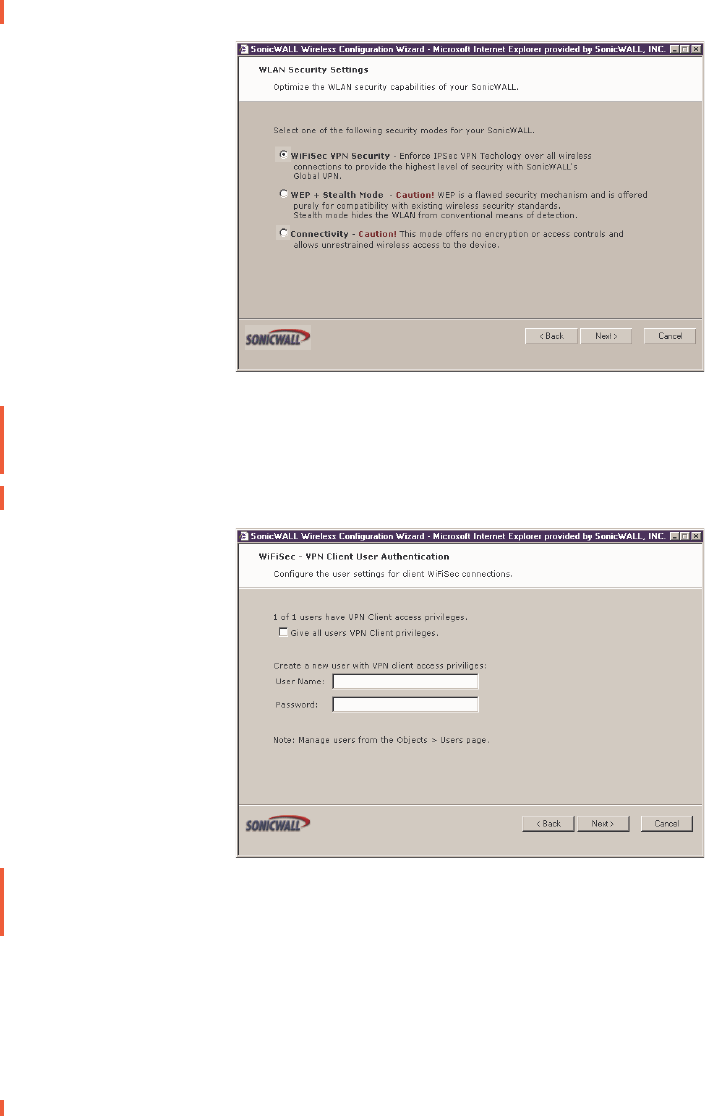
Configuring Wireless on the SOHO TZW Page 29
WLAN Security Settings
4. Select the desired security setting for the SOHO3 TZW. WiFiSec is the most secure and
enforces IPSec over the wireless network. If you have an existing wireless network and
want to use the SOHO TZW, select WEP + Stealth Mode.
WiFiSec - VPN Client User Authentication
5. Select Give all users VPN Client privileges if all wireless clients use the SonicWALL
Global VPN Client software. Create a new user with VPN Client privileges by typing a user
name and password in the User Name and Password fields.
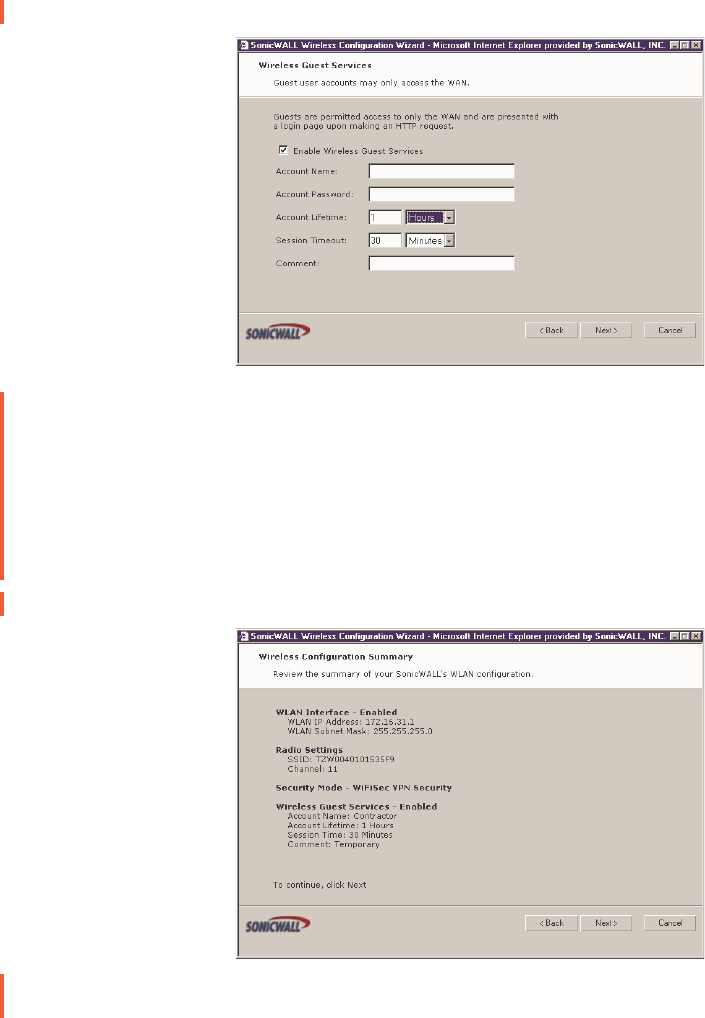
Page 30 SonicWALL Internet Security Appliance Administrator’s Guide
Wireless Guest Services
6. Enable Wireless Guest Services is selected by default. You can create guest wireless
accounts to grant access to the WAN only. If you enable Wireless Guest Services, type a
name for the account in the Account Name field, and a password in the Account
Password field. The Account Lifetime is set to one hour by default, but you can enter a
value and then select Minutes, Hours, or Days to determine how long the guest account
is active. Determine how long the connection can be inactive before disconnecting and
enter the value in the Session Timeout field. Select Minutes, Hours, or Days. Any
comments about the connection can be entered in the Comment field.
Wireless Configuration Summary
7. Review your wireless settings for accuracy. If you want to make changes, click Back until
the settings are displayed. Then click Next until you reach the Summary page.
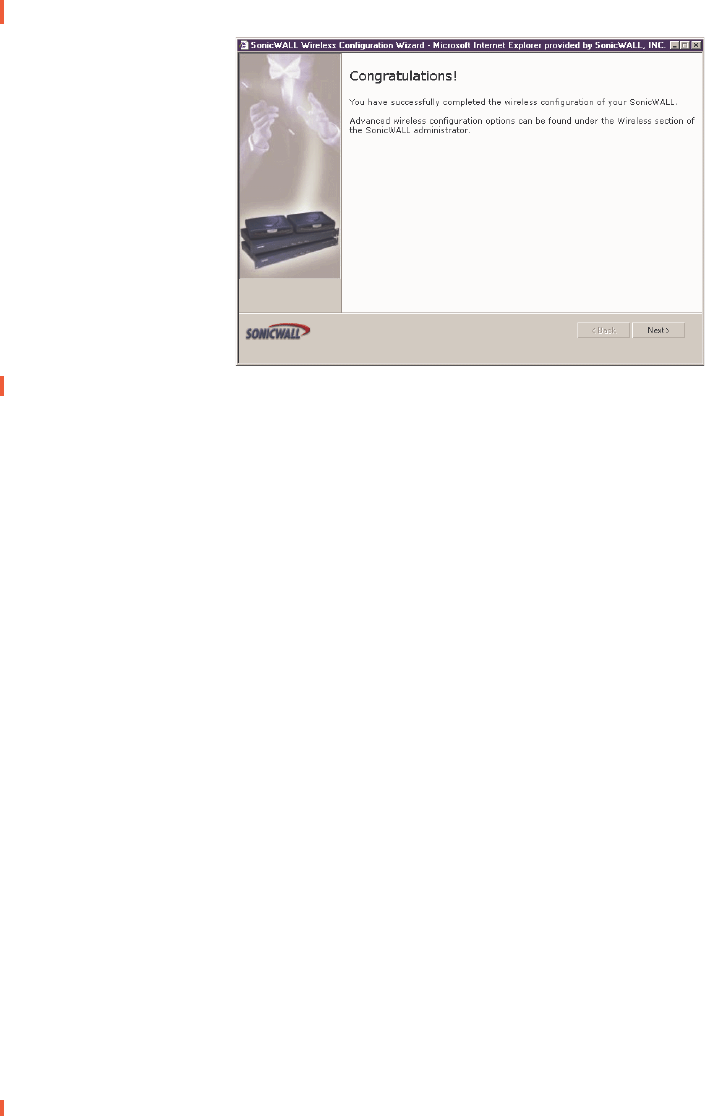
Configuring Wireless on the SOHO TZW Page 31
Congratulations!
8. Congratulations! You have successfully configured your WLAN port on the SOHO TZW.
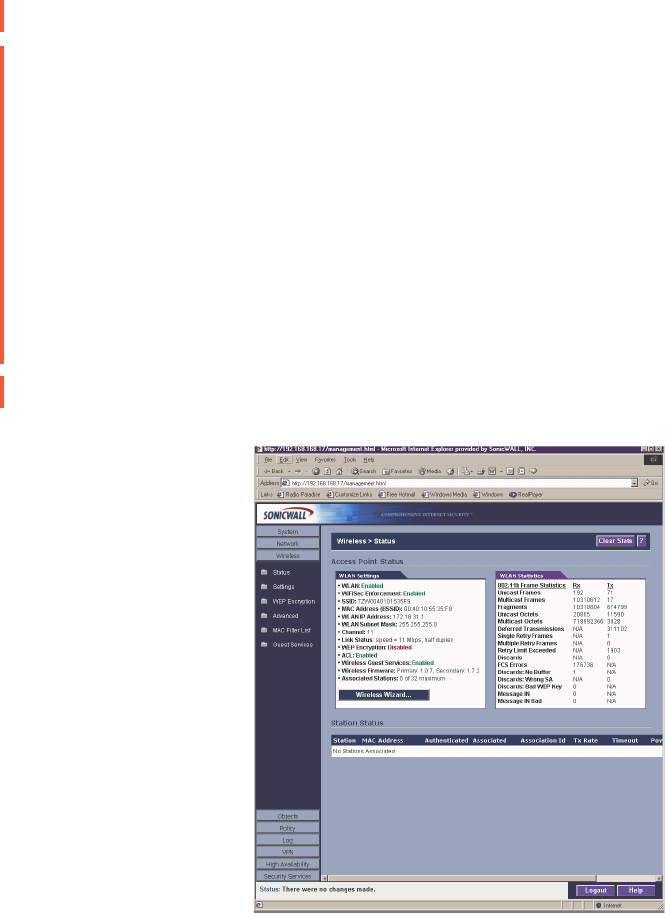
Page 32 SonicWALL Internet Security Appliance Administrator’s Guide
Configuring Additional Wireless Features
The SonicWALL SOHO TZW has the following features available:
•WiFiSec Enforcement - an IPSec-based VPN overlay for wireless networking
•WEP Encryption - configureWired Equivalent Privacy (WEP) Encryption
•Beaconing and SSID Controls - manage transmission of the wireless signal.
•Wireless Client Communications - configure wireless client settings.
•Advanced Radio Settings -
•MAC Filtering - use MAC addresses for allowing access or blocking access to the SOHO
TZW.
•Wireless Guest Services - configure limited access accounts for non-employees.
To begin configuring advanced features on the SOHO TZW, log into the management interface,
and click Wireless. The Status page is displayed and contains information relating to the WLAN
connection.
Access Point Status

Configuring Wireless on the SOHO TZW Page 33
WLAN Statistics
Station Status
The Station Status table displays information about wireless connections associated with the
SOHO TZW.
•Station - the name of the connection used by the MAC address
•MAC Address - the wireless network card MAC address
•Authenticated - status of 802.11b authentication
•Associated - status of 802.11b association
•Association ID - assigned by the SonicWALL
•Tx Rate - in Mbps
•Timeout - number of seconds left on the session
•Power Mgmt - if power management is enabled on your wireless network card, the setting
is displayed here.
•Configure - delete the entry or add the entry to the MAC Filter List.
WLAN Settings Value
WLAN: Enabled or Disabled
WiFiSec: Enabled or Disabled
SSID: Network Identification Information
MAC Address: Serial Number of the SOHO TZW
WLAN IP Address: IP address of the WLAN port
WLAN Subnet Mask: Subnet information
Channel Channel Number selected for transmitting wireless signal
Link Status: Network speed in mbps, full or half duplex
WEP Encryption: Enabled or Disabled
ACL: Enabled or Disabled
Wireless Guest Services Enabled or Disabled
Wireless Firmware:
Associated Stations: Number of clients associated with the SOHO TZW
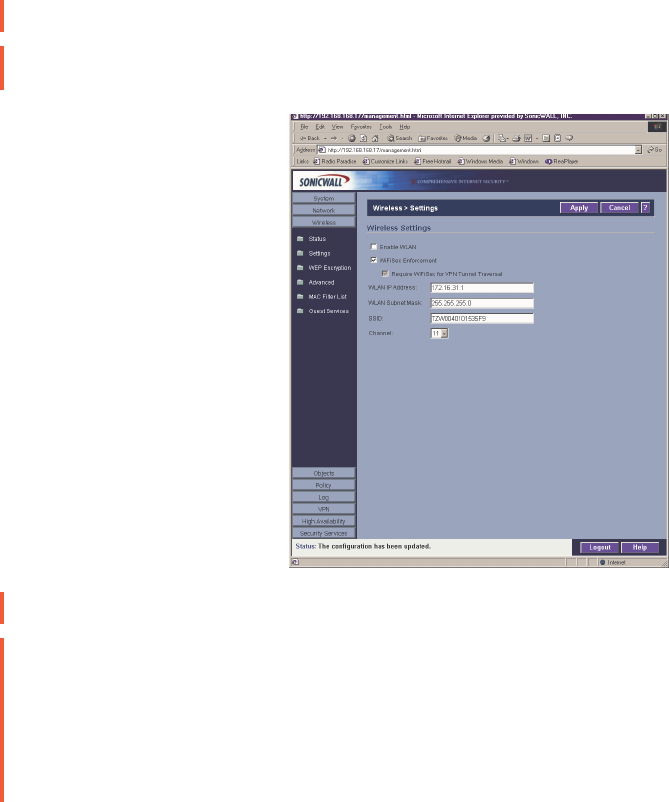
Page 34 SonicWALL Internet Security Appliance Administrator’s Guide
Wireless>Settings
On the Wireless Settings page, you can enable or disable the WLAN port by selecting or
clearing the Enable WLAN checkbox.
WiFiSec Enforcement
Select WiFiSec Enforcement to use IPSec-based VPN for access from the WLAN to the LAN,
and also provide access from the WLAN to WAN independent of Wireless Guest Services.
When WiFiSec Enforcement is selected, a second check box, Require WiFiSec for VPN
Tunnel Traversal is selected by default. When Require WiFiSec for VPN Tunnel Traversal
is selected, any wireless traffic destined for a remote network with a VPN tunnel is secured by
WiFiSec. If WiFiSec Enforcement is not selected, you can select or clear the Require
WiFiSec for VPN Tunnel Traversal checkbox.

Configuring Wireless on the SOHO TZW Page 35
Deployment Scenario for WiFiSec and VPN Tunnel Traversal
A site-to-site VPN tunnel is configured between Site 1 and Site 2, both sites using a SOHO
TZW, and Site 1 has a wireless client on the LAN. When the wireless client at Site 1 attempts
to send data to Site 2 over the VPN tunnel, all data is encrypted between the wireless client,
the SOHO TZW at Site 1, and then over the Internet to Site 2.
To configure the WLAN Settings, log into the SonicWALL, and click Wireless, then Settings.
1. Select Enable WLAN to allow wireless communication over the WLAN port.
2. Select WiFiSec Enforcement to encrypt all traffic over the WLAN. If you choose not to
enforce WiFiSec on your network, clear the check box. You can then select or clear the
Require WiFiSec for VPN Tunnel Traversal check box.
3. Type the IP address of the WLAN in the WLAN IP Address field or use the default IP
address. The default IP address is acceptable for most networks.
4. Type the subnet mask in the WLAN Subnet Mask field.
5. Type a name for the SSID in the SSID field or use the default value which is SonicWALL.
6. Select a channel from the Channel list. The most frequently used channels are 1, 6, and
11. Channel 11 is considered to be the optimal channel for wireless networking.
Insert Graphic Here
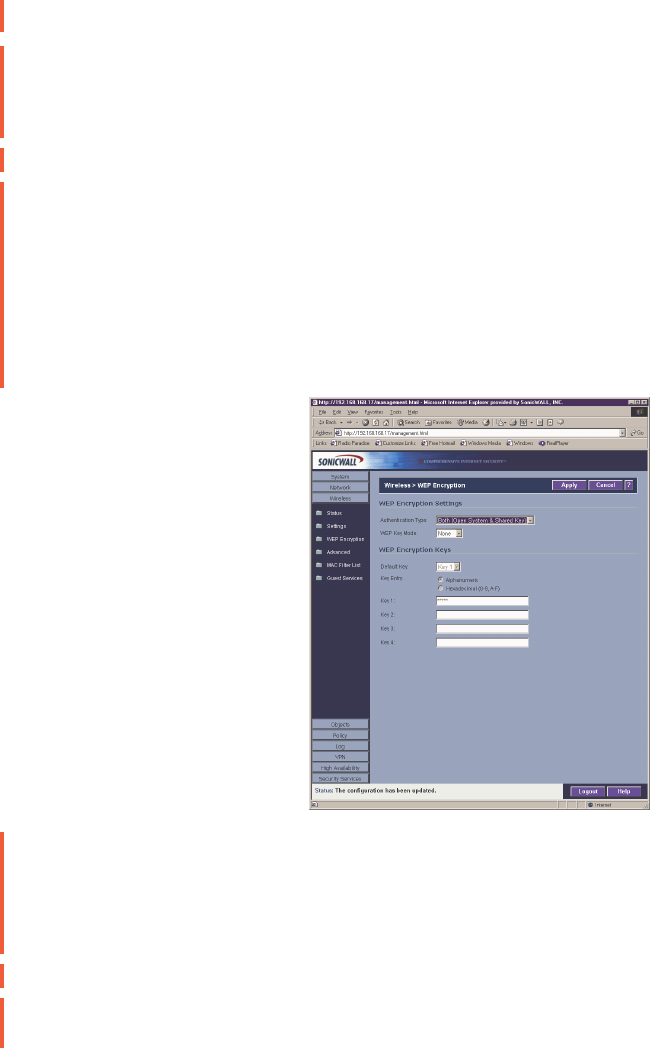
Page 36 SonicWALL Internet Security Appliance Administrator’s Guide
Wireless>WEP Encryption
WEP (Wired Equivalent Protocol) can be used to protect data as it is transmitted over the
wireless network, but it provides no protection past the SonicWALL. It is designed to provide a
minimal level of protection for transmitted data, and is not recommended for network
deployments requiring a high degree of security.
WEP Encryption Settings
Open-system authentication is the only method required by 802.11b. In open-system
authentication, the SonicWALL allows the wireless client access without verifying its identity.
Shared-key authentication uses WEP and requires a shared key to be distributed to wireless
clients before authentication is allowed.
The SOHO TZW provides the option of using Open-system, Shared-key, or both when WEP is
used to encrypt data.
To configure WEP on the SonicWALL, log into the SonicWALL and click Wireless, then WEP
Encryption.
1. Select the authentication type from the Authentication Type list. Both (Open System &
Shared Key) is selected by default.
2. Select 64-bit or 128-bit from the WEP Key Mode. 128-bit is considered more secure than
64-bit. This value is applied to all keys. 64-bit keys are 5 characters long and 128-bit keys
are 13 characters in length.
WEP Encryption Keys
3. Select the key number, 1,2,3, or 4, from the Default Key menu.
4. Select the key type to be either Alphanumeric or Hexadecimal.
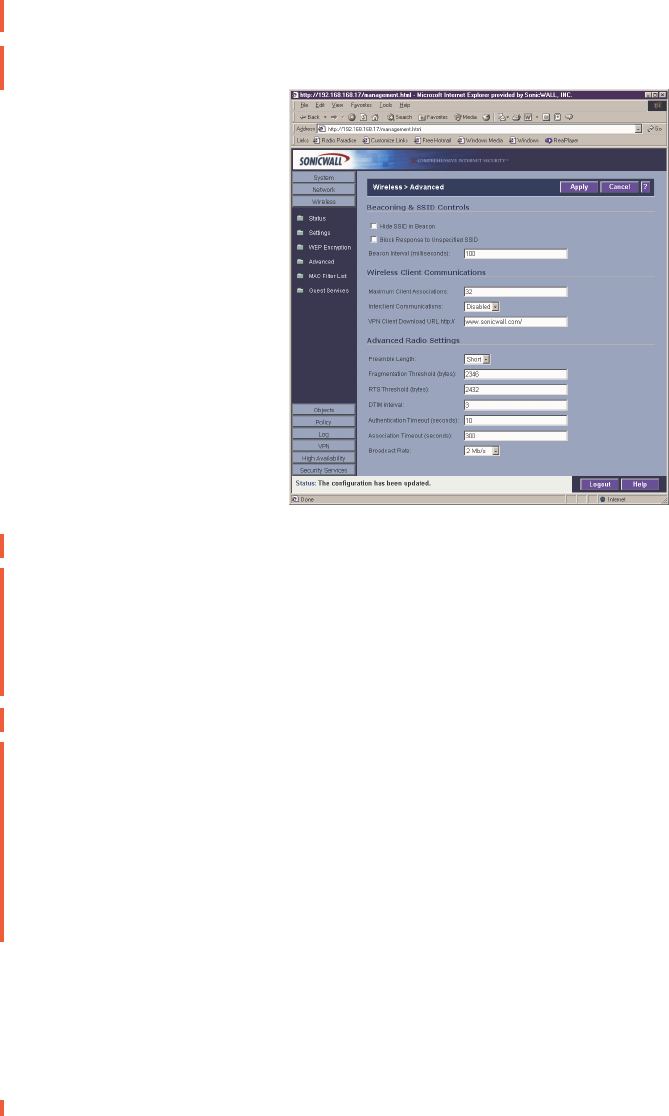
Configuring Wireless on the SOHO TZW Page 37
Wireless>Advanced
To access Advanced configuration settings for the SOHO TZW, log into the SonicWALL, click
Wireless, and then Advanced.
Beaconing & SSID Controls
1. Select Hide SSID in Beacon.
2. Select Block Response to Unspecified SSID
3. Type a value in milliseconds for the Beacon Interval. Decreasing the interval time makes
passive scanning more reliable and faster because Beacon frames announce the network
to the wireless connection more frequently.
Wireless Client Communications
1. Enter the number of clients to associate with the SHO3 TZW in the Maximum Client
Associations field.
2. If you do not want wireless clients communicating to each other, select Disabled from the
Interclient Communications menu. If you want wireless clients communicating with each
other, select Enabled.
3. Guests on the wireless network can download the SonicWALL Global VPN Client to install
on their computer or laptop. Type the URL location for the software in the VPN Client
Download URL http:// field.
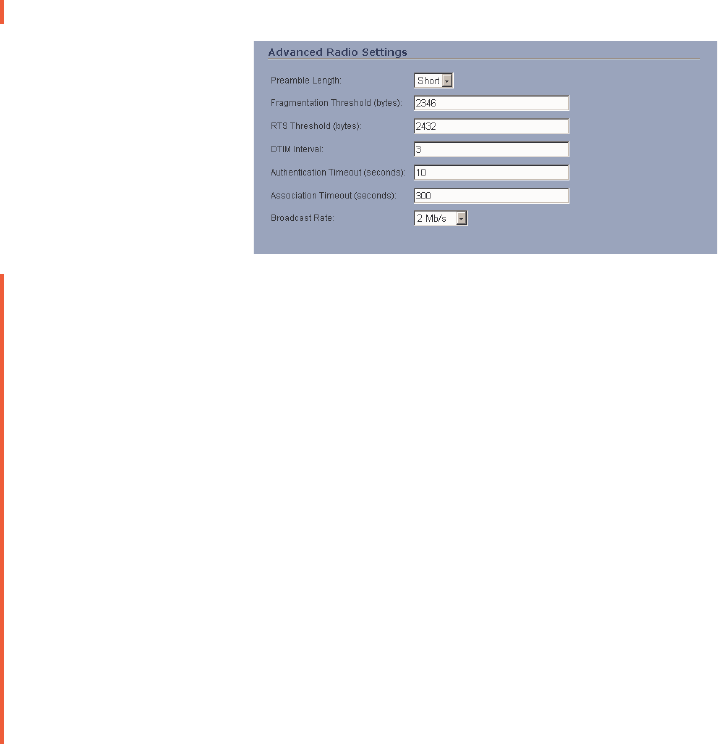
Page 38 SonicWALL Internet Security Appliance Administrator’s Guide
Advanced Radio Settings
1. Select High from the Transmit Power menu to send the strongest signal on the WLAN.
2. Select Short or Long from the Preamble Length menu. Short is recommended for
efficiency and improved throughput on the wireless network.
3. The Fragmentation Threshold (bytes) is 2346 by default. Increasing the value means
that frames are delivered with less overhead but a lost or damaged frame must be
discarded and retransmitted.
4. The RTS Threshold (bytes) is 2432 by default. If network throughput is slow or a large
number of frame retransmissions is occurring, decrease the RTS threshold to enable RTS
clearing.
5. The default value for the DTIM Interval is 3. Increasing the DTIM Interval value allows you
to conserve power more effectively.
6. The Authentication process times out after 10 seconds by default. If your network is very
busy, you can increase the timeout by increasing the number of seconds in the
Authentication Timeout (seconds) field.
7. The Association Timeout (seconds) is 300 seconds by default. If your network is very busy,
you can increase the timeout by increasing the number of seconds in the Authentication
Timeout (seconds) field.
8. Broadcast Rate?
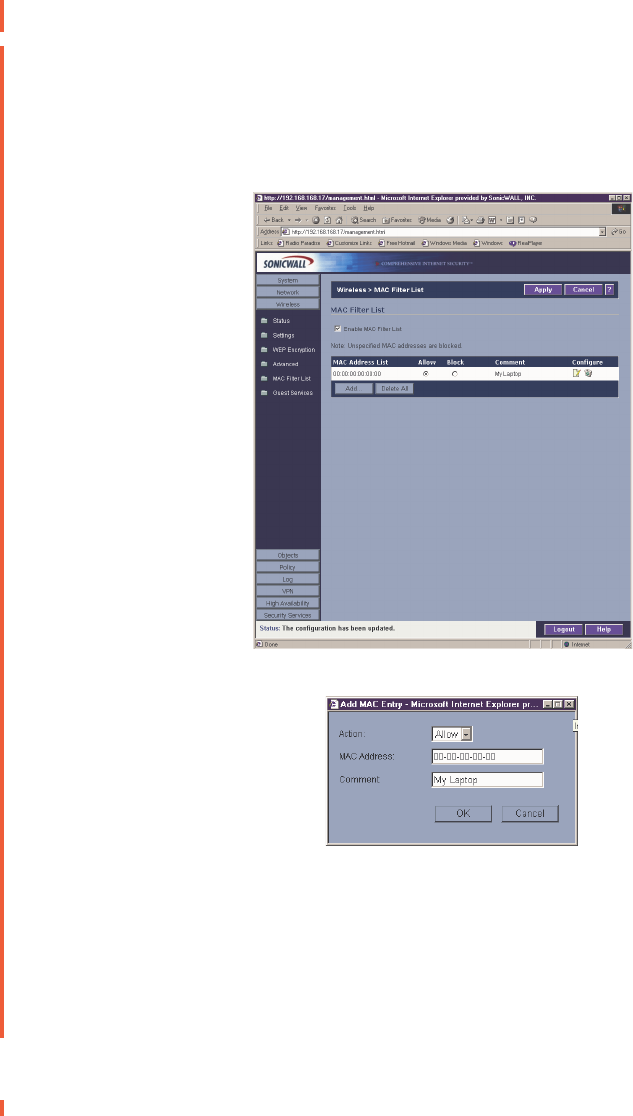
Configuring Wireless on the SOHO TZW Page 39
Wireless>MAC Filter List
Wireless networking provides native MAC filtering capabilities which prevents wireless clients
from authenticating and associating with the SOHO TZW. If you enforce MAC filtering on the
WLAN, wireless clients must provide you with the MAC address of their wireless networking
card.
To set up your MAC Filter List, log into the SonicWALL, and click Wireless, then MAC Filter
List.
1. Click Add to add a MAC address to the MAC Filter List.
2. Select Allow from the Action menu to allow access to the WLAN. To deny access, select
Block.
3. Type the MAC address in the MAC Address field. The two character groups should be
separated by a hyphen.
4. Type a name or comment in the Comment field. The Comment field can be used to identify
the source of the MAC address.
5. Click OK to add the MAC address.
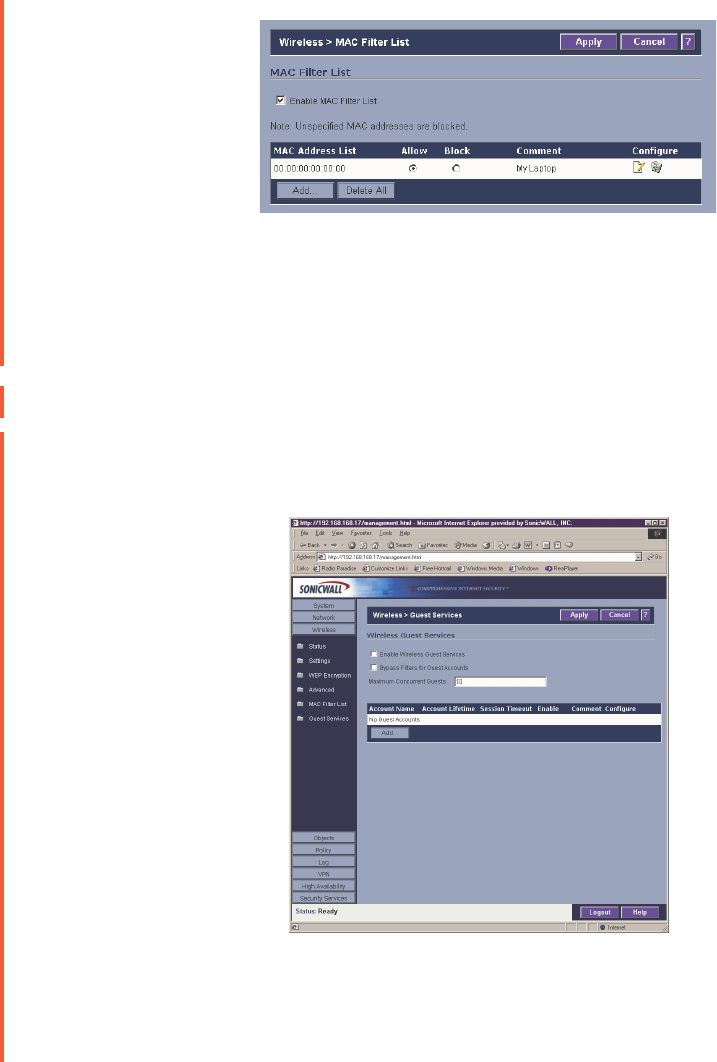
Page 40 SonicWALL Internet Security Appliance Administrator’s Guide
Once the MAC address is added to the MAC Address List, you can select Allow or Block next
to the entry. For example, if the user with the wireless card is not always in the office, you can
select Block to deny access during the times the user is offsite.
Click on the Notepad icon under Configure to edit the entry. Click on the Trashcan icon to
delete the entry. To delete all entries, click Delete All.
Wireless>Guest Services
Wireless Guest Services allow you to create access accounts for temporary use that allow
wireless clients to connect from the WLAN to the WAN. To configure Wireless Guest Services,
log into the SonicWALL, and click Wireless, then Guest Services.
1. Select Enable Wireless Guest Services.
2. If your Guest Accounts are associated with the Users feature of the SonicWALL, you can
select Bypass Filters for Guest Accounts. See the Users, page X, Chapter X, Objects,
for information on configuring User Level Access.
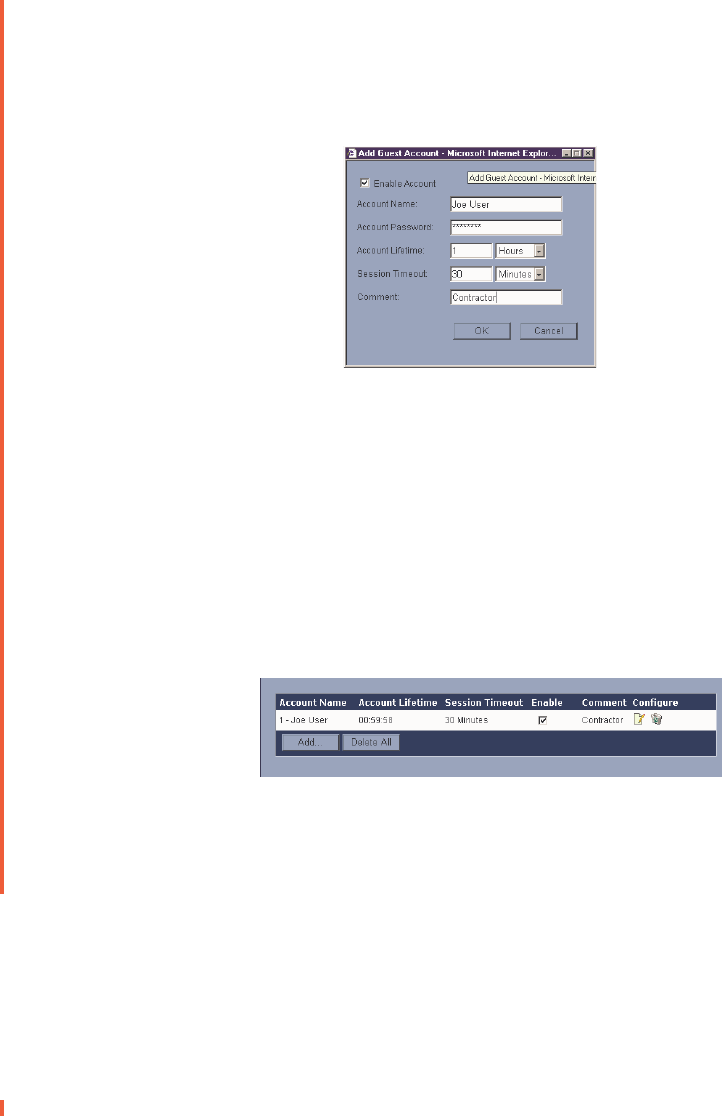
Configuring Wireless on the SOHO TZW Page 41
TIP! You can have Wireless Guest Accounts without configuring User Level Access. Wireless
Guest Accounts are considered more temporary than permanent.
3. Type the number of wireless clients that can use the same Guest Account in the Maximum
Concurrent Guests field.
4. To add a Guest Account, click Add.
5. Enable Account is selected by default.
6. Enter a name for Guest Account in the Account Name field. In the example above, it is
“Joe User”.
7. Enter a password in the Account Password field.
8. Configure the Account Lifetime by entering a value in the field, and then selecting
Minutes, Hours, or Days.
9. Configure the Session Timeout by entering a value in the field, and then selecting
Minutes, Hours, or Days.
10. Enter any comments in the Comment field, and click OK to add the Guest Account.
Guest Account information is displayed in the Guest Account table.
To disable a Guest Account, clear the Enable check box in the Guest Account entry line. To
edit an existing Guest Account, click on the Notepad icon under Configure. To delete a Guest
Account, click the Trashcan icon under Configure. To delete all Guest Accounts, click Delete
All.